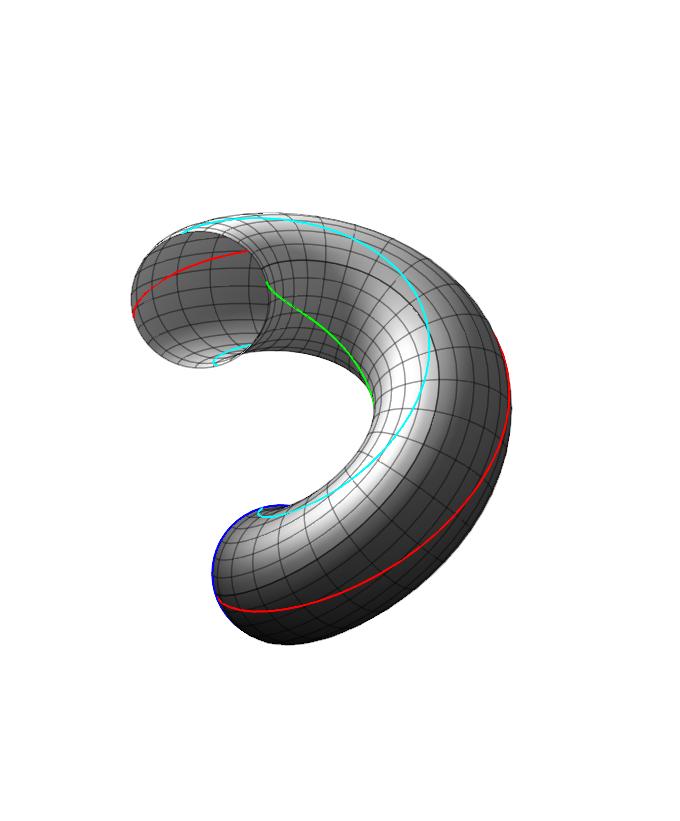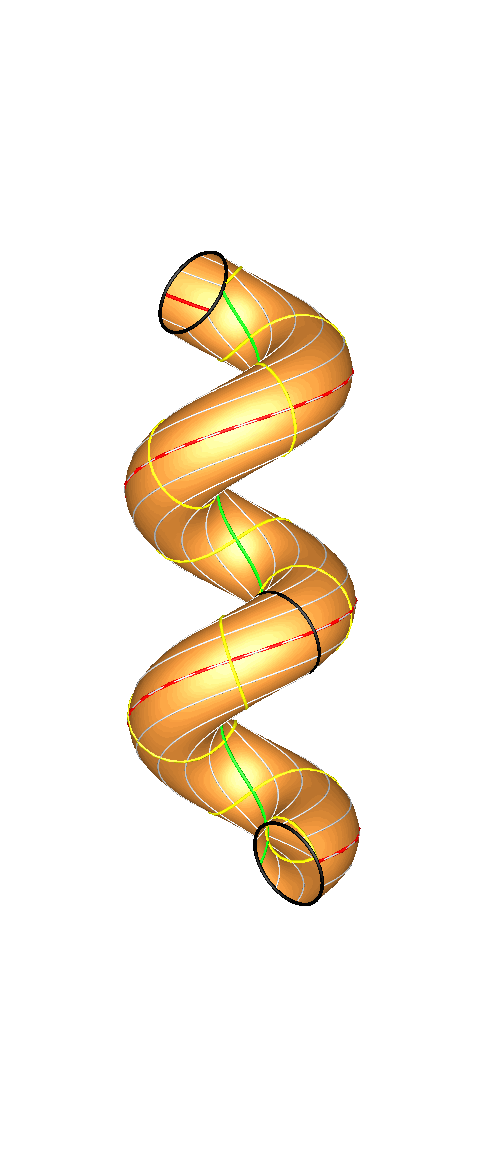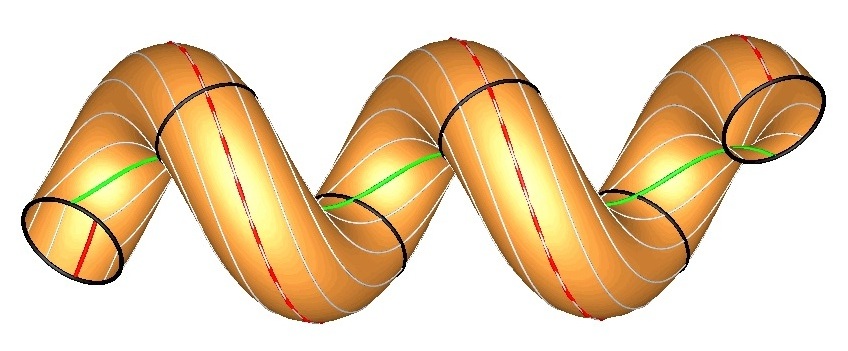tilted cavatappo surfaces:
cavatappo 2.0
Inspired by Chris Rorres' talk on Archimedes screw strakes versus helicoidal designs (September 28, 2012 at Villanova University), and having already had a first go around with corkscrew pasta (cavatappo 1.0), bob was encouraged to consider a generalization of George Legendre's cavatappo design (Pasta by Design, CBS Sunday morning spot) by tilting the vertical circle undergoing the screw rotation. In particular, tilting it back exactly by the upward tilt of the helical center path makes this circle move perpendicular to itself, to give the pleasing shape shown here (just a fixed radius tube or tubular surface of a helix).
George is an architect, so it is not clear how he decided on his representation of the cavatappo other than it was the easiest construction to consider. However, by adding a tilt parameter, one allows the family to specialize to the vertical cylinder and hence capture in one continuous family all the simplest special curved surfaces ranging from the sphere to the torus to helical tube and back to the even simpler cylinder. The real pasta shape in fact is unclear and has ends which are neither vertical as in George's model or orthogonal to the central helix as in this new shape shown to the right (cavatappo 2.0), but then mathematical models are usually simpler than the real world system they model.
While the vertical circular cross-sections (meridians) are not geodesics in George's model, they are in the new model with orthogonal tilting (black curves) as is the case for surfaces of revolution, and they admit simple orthogonal trajectories \( \displaystyle v=v_0 + \frac{8}{17} u\), but which are distinct from the "parallels", unlike the case for surfaces of revolution.
Note the stunning surface graphics of Maple 16!
More to come... stay tuned. (8,15,17) is the fourth
Pythagorean
triple. Math by MathJax.
\[ \displaystyle \left[ \begin {array}{c} x\\ y\\ z\end {array} \right] = \left[ \begin {array}{c} \left( \frac32+\cos \left( v \right) \right) \cos \left( u \right) +{\frac {8}{17}}\,\sin \left( v \right) \sin \left( u \right) \\ \left( \frac32+\cos \left( v \right) \right) \sin \left( u \right) -{\frac {8}{17}}\,\sin \left( v \right) \cos \left( u \right) \\ {\frac {15}{17}}\,\sin \left( v \right) +\frac45\,u\end {array} \right] \]
\[u=0..2\pi,\ v=0..5\pi \]
\[
ds^2 = (dv-\frac{8}{17}du)^2 + \left(\left(\frac32+\cos(v)\right)^2 - \left(\frac{8}{17}\right)^2 \cos^2(v)\right) du^2
\]
Serendipity factor: George picked a frequency \( \displaystyle\frac{5}{2\pi}\approx 0.7958 \sim 0.80 = \frac{4}{5}\) for the central helix so that after one azimuthal revolution around the symmetry axis of the helix at radius \(\displaystyle\frac{3}{2}\), the vertical rise is 5. Using \(\displaystyle\frac{4}{5}\) instead leads to the fourth Pythagorean triple right triangle to describe the helical angle of inclination \(\displaystyle\arctan\left(\frac{4}{5}/\frac{3}{2}\right) = \arctan\left(\frac{8}{15}\right) \). I also rescaled his millimeter units down by a factor of 2 for the mathematical surface, to have simpler numbers. [Sol Lederman in his blog (404) published the model developed in Sander Huisman's blog (404) which used this inclination angle for his cellentani, but a smaller \(b/a=1/2\) ratio than the value \(2/3\) used by George.]
The three black circles are meridians. The red and green curves are the outer and inner equator (maximum positive and minimum positive curvature), while the "parallel" white curves are equally spaced "parallels" (orbits of the screw-symmetry group, lines of constant curvature) between them, spaced at angular intervals of \(\pi/4\). Halfway between the equators are the northern and southern polar circles of zero curvature, separating the two halves of positive (outer) and negative (inner) curvature.
Scroll down below your window for the coordinate/parameter grid plots.
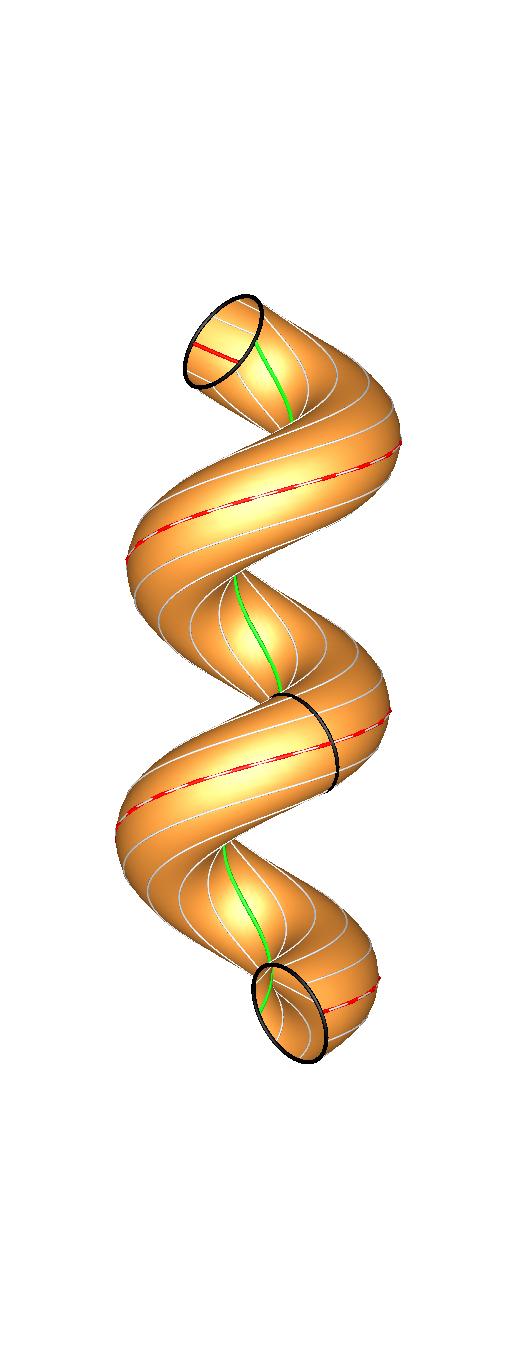
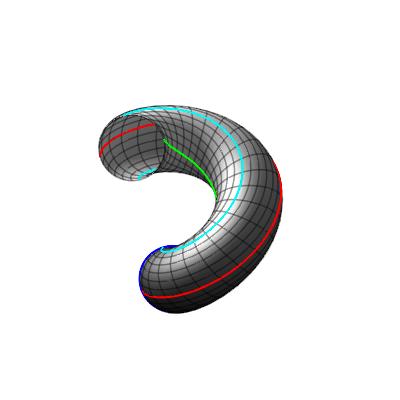
Above: The original grid of meridians and parallels (extension of terminology for surfaces of revolution to screw-revolved surfaces), including the two equators and the two polar circles (terminology extended from the sphere and torus).
Right: The orthogonal grid based on the meridians of the cavatappo 2.0 surface: \( v=v_{new}+\frac{8}{17} u\).
The cyan curves are the northern and southern polar circles which separate the surface into the outer positive curvature region and the inner negative curvature region.
PDF article finalized with live cross-reference and URL links, March
2014:
Cavatappi 2.0: More of the same but better
[also without PDF linking at
http://arxiv.org/abs/1402.3284]
This includes the Lorentz geometry of this orthogonally tilted cavatappo,
which describes the world tube of a spherical body (in its rest
frame---Born rigid transport) in a circular orbit, undergoing Lorentz
contraction and Fermi rotation of its natural comoving grid.
See Abraham, Lorentz, (Poincare), Fermi and Gauss
(and a whole lot of others):
classical electromagnetic mass,
a pedagogical example
VU physics colloquium October 26, 2012
